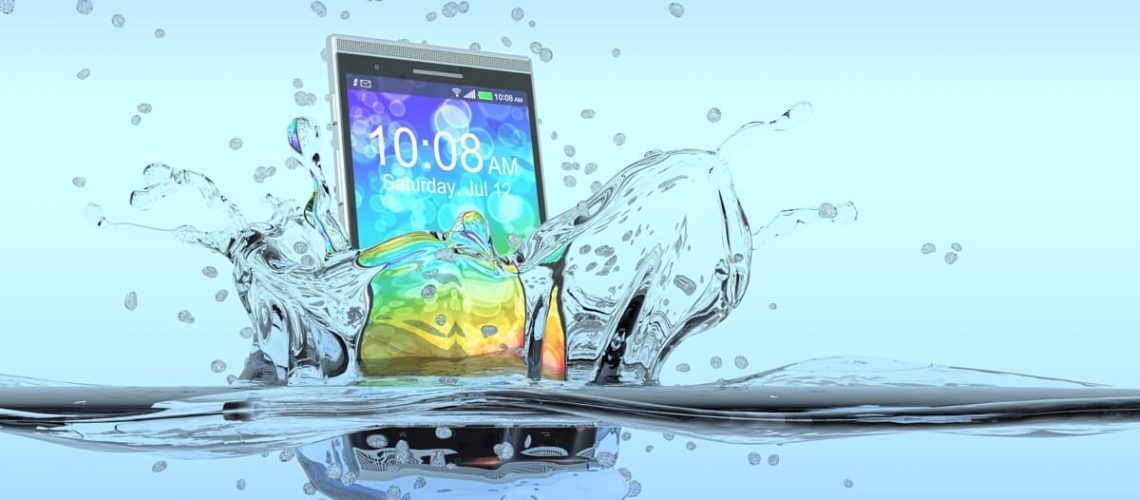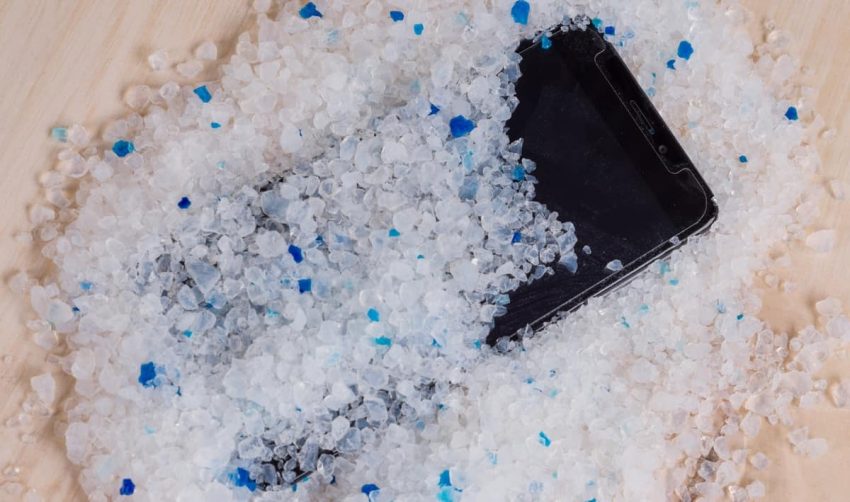- More Baby & Kid
- More Cars
- More Electronics
- More Health & Fitness
- More Hobby & Crafts
- More Home & Garden
- More Other
- More Outdoor
- More Pets
SolidGuides.com may get an affiliate commission when you buy through links on our website. Read More.

Imagine yourself enjoying a cold drink on a hot day with friends. When, suddenly, an innocuous movement of your arm knocks down a glass. You don’t have enough time to react, and the drink is now spilled all over your phone. You are left with a lifeless phone.
We’ve all been in a similar situation at home, work, or outside. We have plopped our phones into water puddles on the street, spilled the tea on them, some of us have even dropped them into the toilet. The pain of having your phone die due to various liquids is real, but everything might not be lost! There are a couple of handy tricks that could save your wet cellphone.
We have decided to help you out by doing the research for you. We went through plenty of different ways of saving your wet phone, and we are going to teach you everything you need to know.
So, before you take your wet phone to a repair shop where they will charge you for their service, you can try out our advice and potentially save money.
Our brains love to play tricks on us during the moments of panic. The same thing happens when our phone gets wet. The first thing that pops into your mind is often not the most correct thing that can be done. So, when your phone gets wet, the first reaction is to dry it. But, plenty of people choose to dry it in one of the following ways, which can only further damage the phone.
Your instincts will tell you to shake the phone, but don’t do it! If you shake or tap your phone, you risk the water reaching further inside of your phone. Do not try to plug it in or charge it, and don’t blow into it!
If your phone dropped into the water and is plugged in, then plug it out immediately. If you grab your phone while it is in water and plugged into a power outlet, then you risk being shocked and seriously hurt.
The longer your phone stays in the water, the more damage it will take. If your phone has been in the water for a long time, then the chances of saving it are slim. But, don’t give up yet!
Don’t wait a single second, simply turn off your phone if it is on. If you leave your phone on while it is wet, then the chances of it short circuiting grow higher.
On the other hand, if your phone is off when it falls into the water, then leave it off. Don’t turn it on to check out whether it is working – curiosity killed the cat.
If you have a protective cover on your phone, then take it off. The same goes for your earbuds and any other accessory you might have.
Even if your phone can’t be saved, you should try to save your data. The SIM card should retain its data, so you will at least save your contacts. The same goes for the microSD card. Take it out as soon as possible, and your important data like photos and videos will have a higher chance of survival.
Unfortunately, most of the smartphones of today don’t have a removable battery. Which is a great shame, because the chances of a phone surviving getting wet are higher when they are not attached to a power source.
If you are one of the lucky owners of a phone with a removable battery, then do it as soon as possible. Lay your phone on a soft cloth or a paper towel, and remove the battery cover. You will probably need a screwdriver to open your phone. But, if you are an iPhone owner, then you need a pentalobe screwdriver.
As soon as you take your battery out, put it on a soft cloth or a bunch of paper towels.
Use a soft piece of cloth or a paper towel to soak up the liquid. Don’t wipe it, because you will spread it around, and you might push the liquid into small openings.
Use a dabbing motion to soak up as much liquid as possible. Use the cloth or a paper towel on the inside of the phone, and on the outside. Try not to move your phone around a lot – you want to avoid moving the water throughout your cellphone.
If your phone has been submerged into water or soaked plenty, then you can try to remove some of the water with a vacuum cleaner.
Fit a hose attachment to the end of the vacuum hose. Set it on the highest setting possible, and bring it close to the phone’s openings. Be sure that you have followed previous steps. You don’t want to suck in your microSD card or other small parts.

A desiccant is a substance that induces a state of dryness in its vicinity. The most famous desiccant that you have probably seen is the silica gel. You have seen it in shoe boxes – small packages filled with tiny transparent beads.
Plenty of guides on the Internet will tell you to use rice, but do it only if you don’t have any silica gel packets lying around.
Take a container and fill it with a desiccant (silica gel, rice, crystal cat litter, oatmeal). Bury the phone and the battery inside the container filled with a desiccant. If you don’t have a container that you can use, then a ziplock bag is a good alternative.
The worst part is in front of you – waiting. Leave the phone to dry for a day or two. Do not be impatient, and don’t try to turn on the phone. We know that the urge to check up on your phone will be high, but fight against it and remain patient.
After 48 hours have passed, remove the phone from the desiccant-filled container. If you have taken out the battery, then now is the time to put it in. Switch the phone on, and hope for the best. If the phone doesn’t turn on, then try to charge it. If your phone doesn’t turn on even after charging, then you should take it to a professional.
You have managed to turn on your cellphone? Great!
Now is the time to check whether everything is working properly. Write a couple of messages or play a game or two. You need to see if the touchscreen is working the way it should be.
Check whether the Wi-Fi is functioning, and play a couple of songs to find out whether the speakers work well. You should also plug in your accessories to notice whether the micro USB is in working order.
Basically, use your phone extensively, and check if everything is the way it used to be.
By now you know what desiccants are, and how to use them. But, we need to bust one myth that has been making its way around the Internet for a long time. Does rice actually help with wet cellphones?
To put it short, no, rice doesn’t help at all! Not only does the rice provide no help, but it can also cause damage. The rice can scratch your phone and leave surface damage. But, more importantly, the dust from the rice can get inside of your phone and cause more harm. To put it short, it is better to leave your phone on a soft towel than to use rice on it.
Tests have shown that silica gel performs the best, and it’s followed by crystal cat litter. Instant couscous and oatmeal performed worse than silica gel and crystal kitty litter. But, they did a better job as a desiccant than uncooked rice.

The reason why instant couscous and oatmeal performed better than uncooked rice is that they are more porous. This means that they take in more water than usual, while uncooked rice underperforms.
Our whole guide works only against plain water. Salt waters like seas and oceans are a different story. The salt found in salt waters does more damage to electronic devices because it is very corrosive.
The best thing to do, if your phone drops into salt waters is to take it to a professional as soon as possible. You should follow our above guide, but only up to the point where you need to put your phone into a desiccant. Skip that step, and take your phone to a professional.
There are some phones out there that are marketed as waterproof or water-resistant. But, the reality is different than the advertisements.
First of all, none of the companies will ever claim that their phone is waterproof since that is currently impossible. The only claim that a smartphone manufacturer will make is that a phone is water-resistant.
Water-resistant phones can’t be taken for a swim. Most of them can only handle being used for a couple of minutes under light rain. Some of the models have better water resistance, but even those models can only survive direct contact with faucets and accidental submersions. Only a few expensive models can be submerged up to 3.3ft into the water, and only for half an hour.
You can plainly see that water-resistant phones offer limited protection against liquids.
Accidentally spilling water on your phone is a problem, but you can see that there are ways of rectifying the problem, provided that you react quickly.
Try not to panic, remain calm, and the chances of you saving your wet cellphone will be higher. Be careful with your cellphone, even if it is water-resistant, and you won’t have to follow our guide.
We hope that we have managed to help you save your wet cellphone and that you didn’t have to spend a single cent. Now go out, and share your cautionary tale with the others.